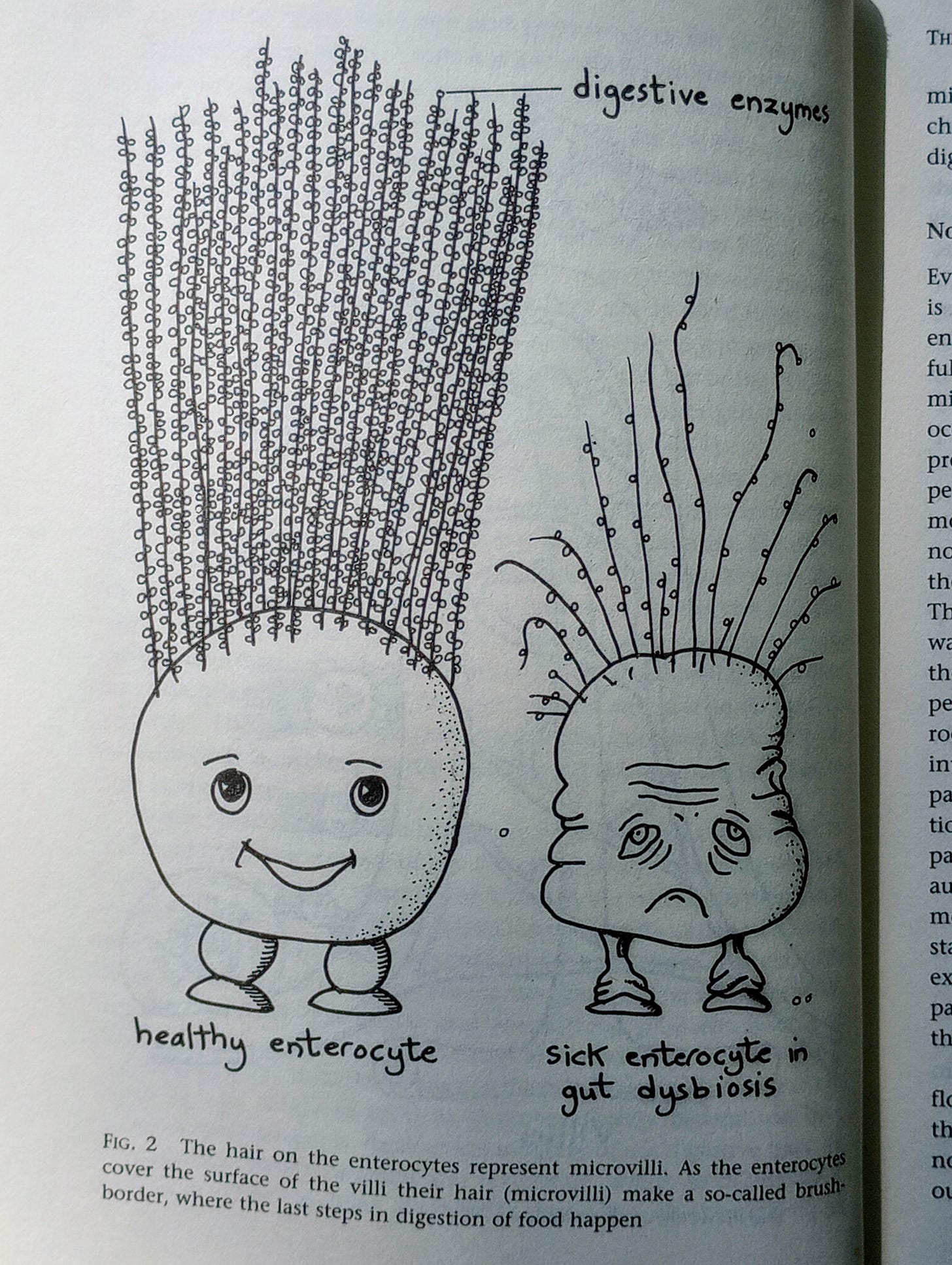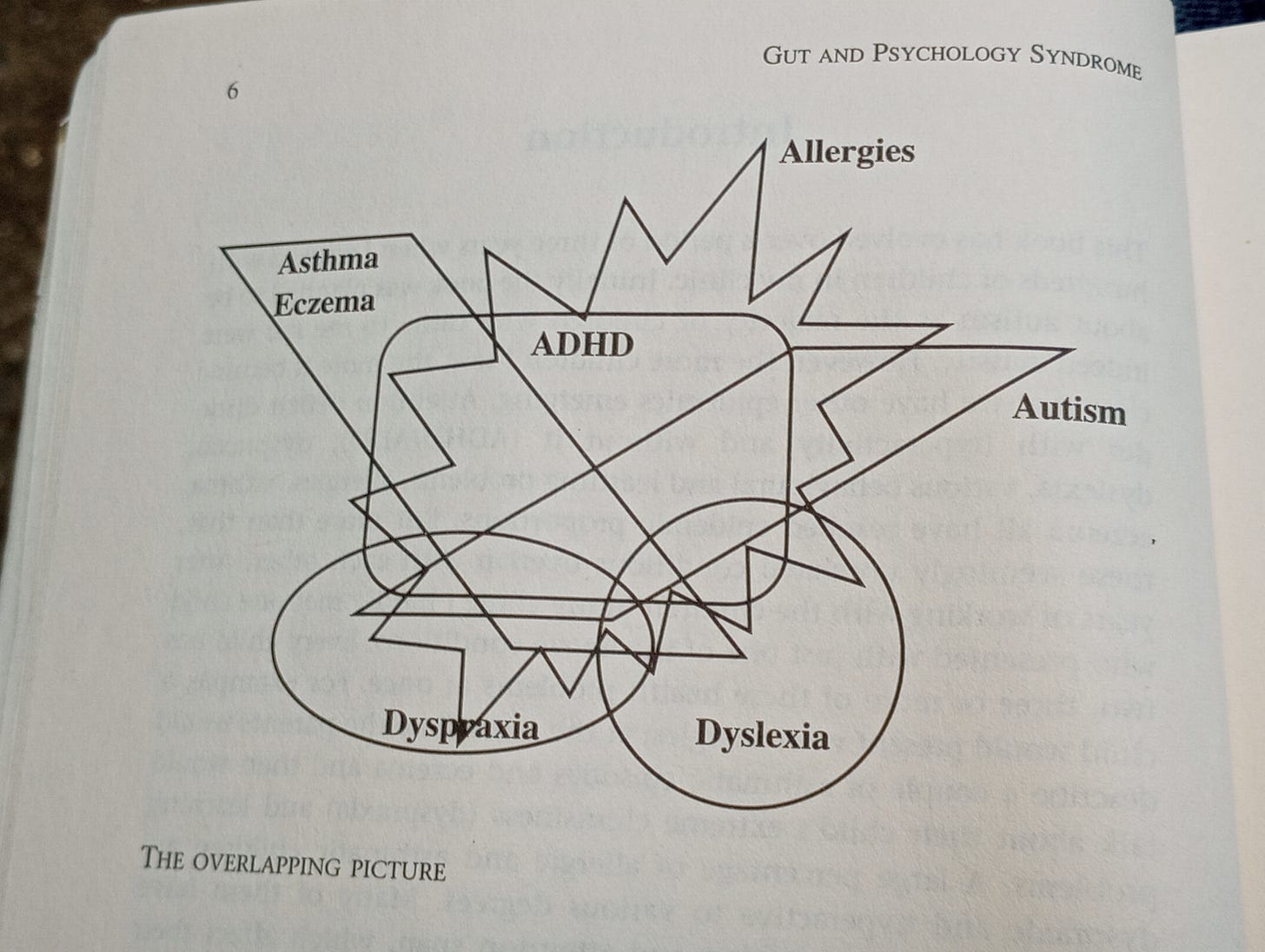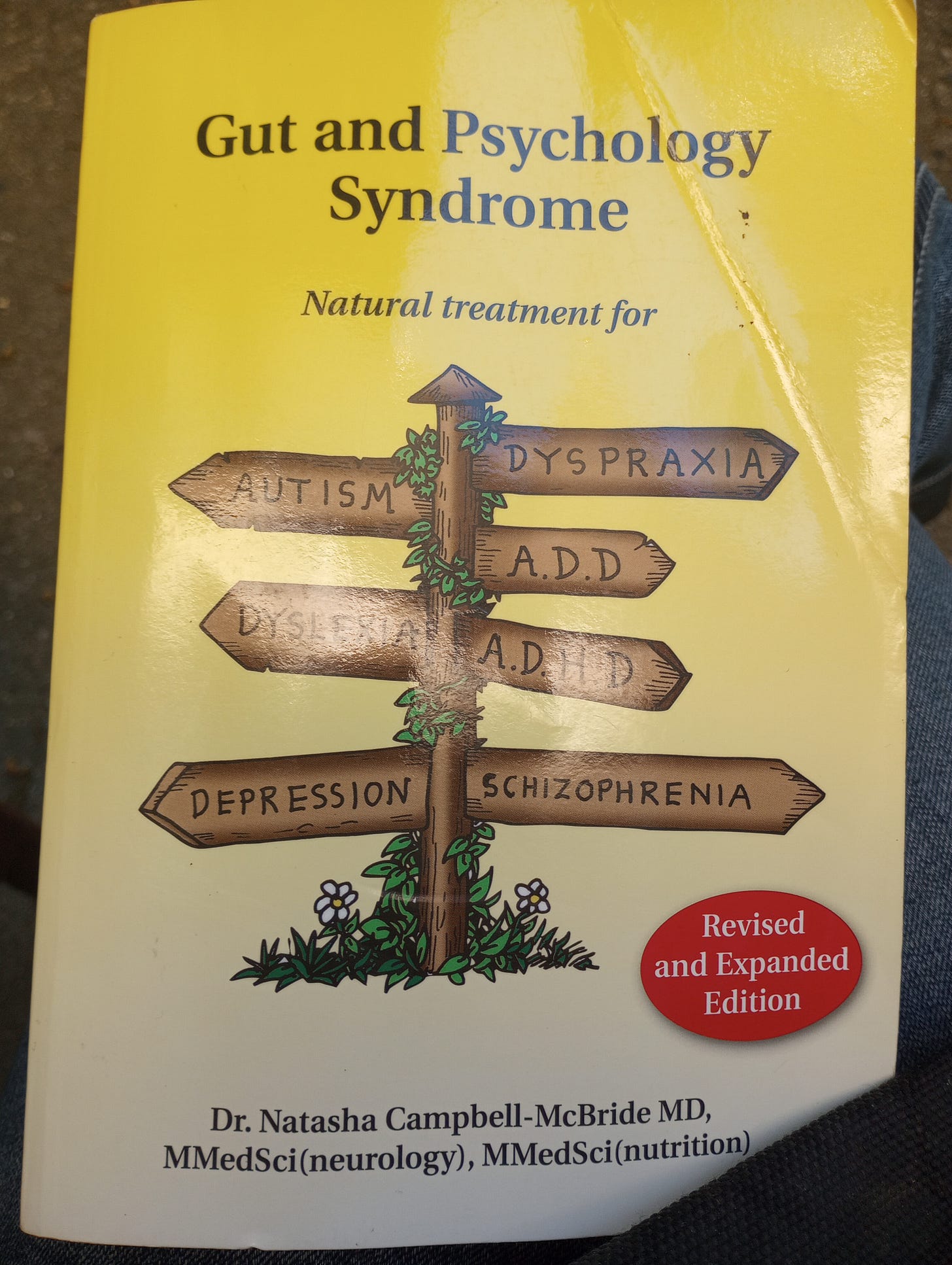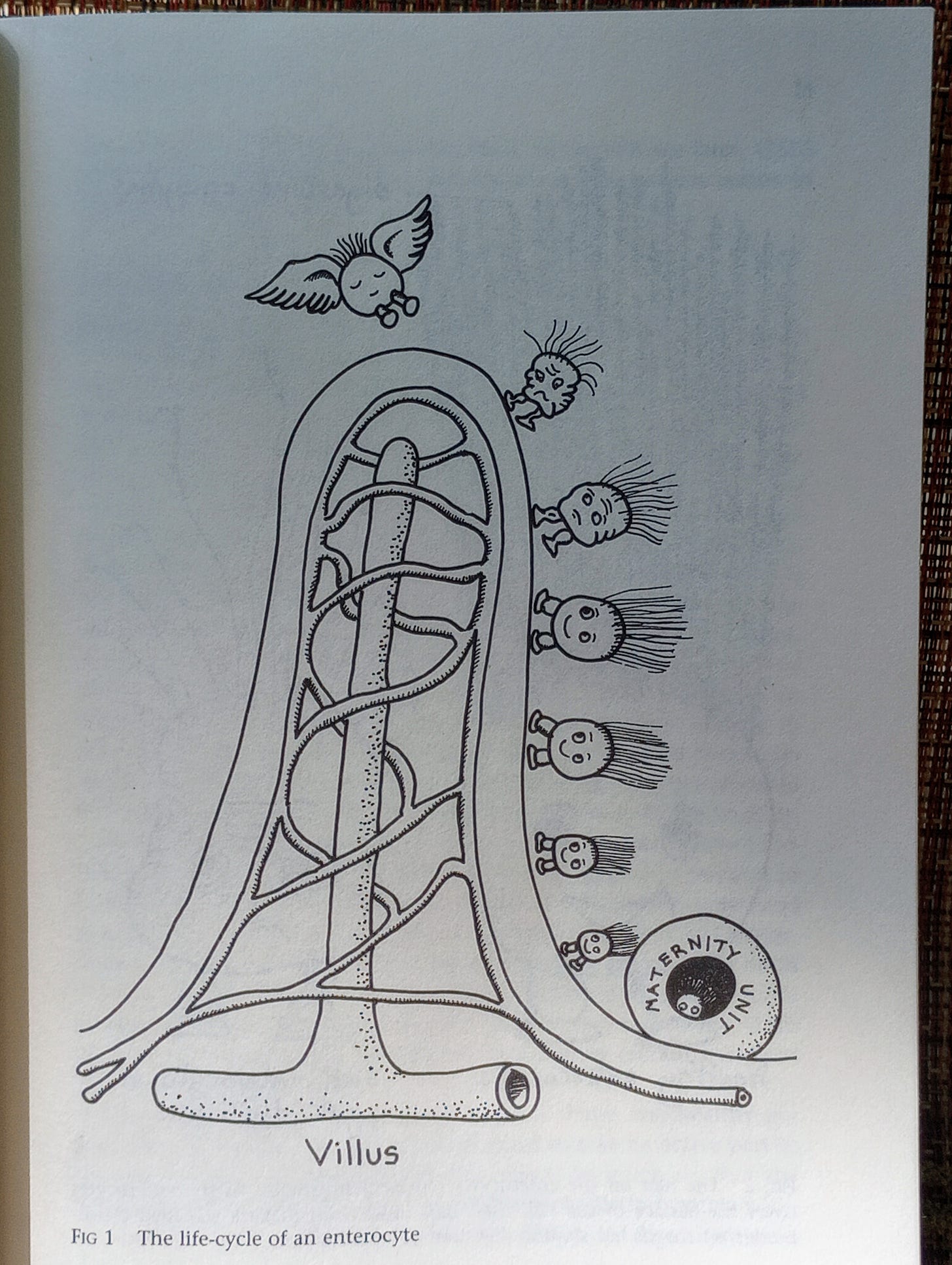Healthy gut lining is needed for starch & protein digestion. Poor starch digestion -> bacterial overgrowth; Also, methylation needs molybdenum, manganese & magnesium - the 3Ms.
GAPS diet - Gut and Psychology Syndrome by Dr. Natasha Campbell-McBride, MD, MMEDSci in neurology and nutrition; and Bridget Briggs, MD & Chris Masterjohn, PhD on methylation. Molybdenum food sources.
The gut-brain needs microbes for peristalsis to function well. They stimulate more white blood cells that also have a supporting role for the Enteric nerve cells - the gut brain cells. Without any microbiome signaling stimulating a need for immune support the cells don't develop into that role of glial like support cell in the brain. And those cells help promote better smooth muscle function or more of it, more peristalsis to keep everything moving along. (Different post)
When the intestinal lining is harmed or too coated in thick mucus as is seen in Cystic fibrosis, then disaccharidase enzymes needed to digest starches and paired sugar disaccharides are not available. The outer fringe layer of the intestinal lining is where those enzymes are made. Lose those cells and you lose those enzymes. Lactose milk sugar is a disaccharide and anyone can have trouble digesting it after a recent diarrhea illness, even if normally you can digest milk sugar okay.
While the gut is recovering from the recent illness, then avoid the indigestible food - milk products in this example. Once the diarrhea illness is over gradually ease back onto dairy products with tiny servings at first. If too much starch is eaten and we can't digest and absorb it, then the gut microbes will have a huge feast!
And they will multiply and produce gaseous waste, puffing you up like a Puffer fish.
🦠🦠🦠🦠🦠🦠🦠🦠🦠🦠🦠🦠🦠🦠🦠🦠🦠🦠🦠🦠🦠🦠🦠🦠🦠🦠🦠🦠🦠🦠🦠🦠🦠🦠🦠🦠🦠🦠🦠🦠🦠🦠🦠🦠🦠🦠🦠🦠🦠🦠🦠🦠🦠🦠🦠🦠🦠🦠🦠🦠🦠🦠🦠🦠🦠🦠🦠🦠🦠🦠🦠🦠🦠🦠🦠🦠🦠🦠🦠🦠🤢
Leaving you, not feeling well, gassy, bloated farting, — but not smelly flatulence.
If there is also trouble digesting proteins then the gas will be smelly too. Eggs, poorly digested, can lead to the ammonia smell of hydrogen sulfide in the flatulence. The microvilli of the enterocytes also make peptidase which breaks down protein fragments into amino acids or smaller peptides.
Poo from a fully breastfed baby doesn't smell bad, and may even smell a little sweet. Add baby food and the smell arrives.
So that is potential gut issue number one - starch intolerance due to loss of function of the villi of the brush border of the intestinal lining.
Or that might be gut issue number two - a chicken or the egg question, which came first?
Someone might develop an unhealthy intestinal lining for a variety of reasons - figuring out which is the tricky part.
Protein digestion is also impaired if the microvilli of the enterocytes are damaged.
Gluten/gliaden protein and similar proteins in barley, rye, and other grains can cause us to make zonulin which opens the Tight Junctions between intestinal cells which lets larger molecules into our blood stream and inner body. Corn also can cause the zonulin opening of Tight Junctions and oats and rice may have similar proteins too.
Early research and care of “Celiac” patients found that limiting starch and disaccharides helped restore the gut to health — so it must be a starch intolerance right? No, later research dominated with the evidence against gliaden/gluten in wheat and rye. Just avoid those two grains and you can have other starches — so therefore Celiac disease is a protein intolerance not a starch intolerance. That is where the mainstream medical world is at - gluten is the problem.
Yet, starch digestion will be reduced in anyone whose intestinal lining has damaged micro villi - the lining is like mountain ranges, lots of hills and valleys to maximize absorptive surface. But if a bad diarrhea illness sand papered off the mountains, and it was a flat desert land, then anyone might have trouble digesting starches. And that could lead to an overgrowth of the gut microbiome and some severe bloating which can be very painful as well as audibly embarrassing. It seems like a combined problem at least until the gut lining is healed enough to be making disaccharidase and peptidase again.
We have an adorable graphic to help us visualize our intestine’s enterocytes from the book Gut and Psychology Syndrome by Dr. Natasha Campbell-McBride. Very basic nutrition - you need to be able to digest proteins and absorb amino acids or peptides in order to make more cells or digestive enzymes. Folate and other B vitamins are also needed.
Enterocytes form the very outer layer of the intestinal wall and they have microvilli extending outward which are coated with digestive enzymes. Younger enterocytes have more and start their life at the base of a villi. As new ones are formed at the base, older ones are shoved upwards. At the peak the enterocytes are are older and are sluffed off eventually. In an unhealthy gut situation too many would have been sluffed off and hardly any digestive enzyme containing microvilli are left.

Gut dysbiosis could then lead to more toxin production from negative species and more of an immune reaction by our body and increased mucus production along the intestinal lining which would reduce starch and peptide digestion because the villi enzymes would be more out of reach behind the thickened mucus/biofilm layer.
Children with Cystic Fibrosis have too much mucus production all of their lives due to a gene difference and they may need to reduce their starch intake all of their lives or take digestive enzymes before meals. They also wouldn’t be having thorough protein digestion as access to the peptidase from the microvilli would also be limited by a thick mucus layer.
The stomach enzymes break the grain proteins down to the gliaden/gluten point but the microvilli peptidase is needed to break it down further. If it enters the body whole it will be formed into a morphine like chemical that can be addictive. The person with the leaky gut may be find the inflammatory proteins stimulating or calming and then want to eat more and more of the wheat or other grain. Children on the autism spectrum often have very odd eating patterns which may include a lot of gluten and dairy. Casein protein from dairy also can cause a morphine like chemical if absorbed with incomplete digestion and soybeans also contain.
We make a biofilm or glycocalyx layer over our mucus membranes and bacteria can protect themselves that way too. We learned that EMF exposure increases bacterial biofilm and antibiotic resistance in a recent post from Roman Shapoval. Many things can be involved in excess stress on the body which then leads to gut dysbiosis.
Using a starch restricted diet for a healing phase of a few weeks to months can eventually lead to the person being able to eat starches more normally again - once the villi lining the intestines are restored the disaccharide digestion should function again.
Avoid gluten for life if an autoimmune condition occurred.
BUT if an autoimmune sensitivity had already been set up against gluten protein and also our thyroid tissue then avoiding gluten for all of life would be safest. The risk is if the gut gets leaky again, however gluten and proteins in other grains can signal zonulin to open Tight Junctions between the intestinal cells and let larger proteins through, like gluten, where it could bump into Memory B cells that make more anti-gluten/thyroid antibodies. Hashimoto’s autoimmune disease likely requires avoidance of gluten for the rest of the person’s life, as the Memory B cells remain ready to make more antibodies at any time.
Fermentation of grains or dairy helps break down the problem proteins and makes them safer for the average person who doesn’t already have an autoimmune sensitivity.
AND for everyone else, fermenting or not using gluten grains and dairy casein and soy might be safest, as the proteins that are good at causing leaky gut can also cause damage within the body when they leak through the opened Tight Junctions which they signal zonulin to allow. Gluten is like a home invader that knows the door code (zonulin) which allows the gluten to be buzzed in the front door. It rang the doorbell after all. Fermentation of dairy, soy, and grains helps break down some of the negative proteins before the food will be eaten. The flaw with fermentation is that histamine sensitive people would get worse from those foods or beverages.
Emotional or physical stress of some sort might come first in the chicken or egg question of what causes gut dysbiosis… and poor digestion of food… and malabsorption of nutrients… and over absorption of bacterial toxins… and poor energy level, brain fog and disordered thinking… and maybe hyperactivity, recklessness, mania or other behavior symptoms.
The autism epidemic is also an allergy, asthma, eczema, ADHD, dyslexia and dyspraxia epidemic according to Dr. Campbell-McBride
In her book Gut and Psychology Syndrome, Dr. Natasha Campbell-McBride, MD, said we were not just having an epidemic of autism. We were having an epidemic of allergies, asthma, eczema, ADHD, dyslexia and dyspraxia (clumsiness) — and that these conditions were often overlapping within children — many with multiple conditions.
Gut and Psychology Syndrome, Dr. Natasha Campbell-McBride, MD, gapsdiet.com

I resemble the above graphic, my Venn diagram would have all the intersections except dyslexia. I have improved my allergies, asthma and eczema history.
The reason to care, if you resemble this graphic, is that when untreated, the pathway into the future tends to lead to bipolar disorder, schizophrenia, and later Alzheimer's dementia. Figuring out the causal links and changing directions earlier in life would seem sensible…if we knew which direction we needed to go to avoid those destinations.

Removing problem proteins and starches and anything else causing inflammation is the direction we need to go to restore health and improve function. Gene changes may be involved in which case figuring out if high dose supplements are needed and taking those for life may be a step to take towards improved health.
Science gets too hung up in jargon and credit and can lose sight of the person in pain.
*And now we need to keep in mind that outright lying and fraud has been happening in support of some unspoken agenda whether it is pharma profit or population culling. If “research” findings seem odd, keep looking at the larger body of evidence about the topic. The glossy new study might be a well funded con job.
Methylation cycles are very complex and can be intimidating to learn. Bridget Briggs, MD provides a helpful overview of the interconnected cycles and tips for working with different types of dysfunctional alleles. Just providing methyl folate (* but not synthetic folic acid - avoid eating that) might make some types of gene differences worse while helping resolve gut problems for people with other types of gene alleles.
Dr. Briggs also stresses that when multiple cycles are disrupted, work on repairing the transsulfuration one first, because it is needed to help clear out a lot of different types of drugs and hormones or neurotransmitters. When it is disrupted, everything else will remain messed up too. => Step one repair sulfation pathways.
Extra manganese (quite a lot was mentioned, 10 mg twice a day, which is pushing the upper limits of toxicity), molybdenum, magnesium, and a little extra vitamin B6, or P5P the bioactive form of B6, and maybe SAMe, and supplements of phosphatidylserine generally are helpful. Dr. Briggs calls the minerals the 3 Ms - we need a magnesium for every single ATP reaction that occurs. Molybdenum and manganese help our sulfation pathways but we can’t forget the magnesium.
Pure maple syrup is an excellent source of manganese and magnesium and other trace minerals.
The molybdenum is needed to help excrete sulfated forms of other chemicals like excess of sulfated estrogen. Sulfation makes the chemical inactive, but then we still need to excrete it. Too much sulfated chemicals hanging around is likely adding to ‘ama’ - cellular debris that needs to be flushed out somehow. Dr. Briggs says molybdenum helps clear sulfated chemicals. Molybdenum food sources include nuts, beans, whole grains, and leafy vegetables. (Molybdenum Fact Sheet/NIH)
An excess of SAMe as a supplement might inhibit other parts of the methylation cycles and it is expensive.
If a vitamin B6 tablet seems to make no difference, but you suspect you have issues, then test the more bioactive P5P form. Some people need that form, others can get by with the B6. With pyroluria, I need to take high dose B6 daily, but either form seems to work for my symptoms. Lack of it adds to anxiety.
Phosphatidylserine is in some foods - meats, organ meats, brain, liver, eel and fish, soy lecithin, white beans, or just get the supplement if you are trying to tackle a health issue and are eating vegan/vegetarian. Phosphatidylserine is not an inexpensive supplement, but bulk powder is cheaper. (bulksupplements.com) Sunflower lecithin would have some phosphatidylserine and phosphatidylcholine (which is also helpful for methylation function) and sunflower lecithin may be better tolerated than soy lecithin. Very strong emulsifiers can emulsify the intestinal lining and cause gut problems - we don’t want that. (PureBulk.com) Serine has calming effects within the brain.
Dysfunctional sulfation pathways may involve too little or too much activity. Upregulation of the CBS gene, (a C699T allele) can lead to excess homocysteine production and too much taurine. Checking homocysteine levels isn’t a routine lab test but it is simple to do, just ask for it. An excess of homocysteine is a biomarker for heart disease risk.
Problems with other genes involved in sulfation (“SULT1A3 and SULT1A4 genes”) can lead to accumulation of catecholamines - the fight or flight chemicals, adrenaline, epinephrine, and norepinephrine. Serotonin is also deactivated by sulfation. (Bairam, et al., 2018)
Symptoms or conditions involving dysfunction in sulfation might include: Irritable Bowel Syndrome, (IBS), Small Intestine Bacterial Overgrowth, (SIBO), Gastroesophageal Reflux Disease, (GERD), Joint and Tendon Pain, Poor Digestion and Detox, Anxiety, and Insomnia.
The Power of Methylation with Dr. Bridget Briggs, MD, Hawthorn University, 3/02/2021, (Youtube)
This shorter video is at a more introductory level: Methylation | The Best Kept Optimal Health Secret; Ultimate Human Podcast, (Youtube)
Molybdenum content in foods, (Molybdenum Fact Sheet/NIH)
Food Micrograms (mcg) per serving Percent DV
Black-eyed peas, boiled, ½ cup 288 640
Beef, liver, pan fried, 3 ounces 104 231
Lima beans, boiled, ½ cup 104 231
Yogurt, plain, low-fat, 1 cup 26 58
Milk, 2% milkfat, 1 cup 22 49
Potato, baked, flesh and skin, 1 medium 16 36
Cheerios cereal, ½ cup 15 33
Shredded wheat cereal, ½ cup 15 33
Banana, medium 15 33
White rice, long grain, cooked, ½ cup 13 29
Bread, whole wheat, 1 slice 12 27
Peanuts, dry roasted, 1 ounce 11 24
Chicken, light meat, roasted, 3 ounces 9 20
Egg, large, soft-boiled 9 20
Spinach, boiled, ½ cup 8 18
Beef, ground, regular, pan fried, 3 ounces 8 18
Pecans, dry roasted, 1 ounce 8 18
Corn, sweet yellow, cooked, ½ cup 6 13
Cheese, cheddar, sharp,1 ounce 6 13
Tuna, light, canned in oil, 3 ounces 5 11
Potato, boiled without skin, ½ cup 4 9
Orange, medium 4 9
Green beans, boiled, ½ cup 3 7
Carrots, raw, ½ cup 2 4
Asparagus, boiled, ½ cup 2 4
~~~
I have been eating an extraordinary amount of pecans lately (2 pound bags of pecans go pretty quick on my vegan diet). Eight ounces of pecans times 8 mcg means that I should make more black-eyed peas at 288 mcg per 1/2 cup cooked. Black-eyed peas also win the easiest to digest/nutritious legume award - less phosphorus to magnesium and calcium and they are low in oxalate and have less negative plant lectins that are found in kidney shaped beans. Lima beans are also good for those reasons but are a goitrogen, while Black eyed peas are not.
Bonus video with fellow Substacker Chris Masterjohn
Methylation, MTHFR, and Histamine with Chris Masterjohn, PhD, Hawthorn University, 10/09/2019 (Youtube).
Methylation Overview for Health Professionals, a document by Chris Masterjohn, PhD. (pdf)
I find it helpful to hear a variety of voices regarding complex topics. We all tend to focus on different parts of the bigger picture.
Disclaimer: This information is being provided for educational purposes within the guidelines of Fair Use and is not intended to provide individual health care guidance.
Reference List
(Bairam, et al., 2018) Bairam AF, Rasool MI, Alherz FA, Abunnaja MS, El Daibani AA, Gohal SA, Kurogi K, Sakakibara Y, Suiko M, Liu MC. Sulfation of catecholamines and serotonin by SULT1A3 allozymes. Biochem Pharmacol. 2018 May;151:104-113. doi: 10.1016/j.bcp.2018.03.005. Epub 2018 Mar 8. PMID: 29524394; PMCID: PMC5899928. https://www.ncbi.nlm.nih.gov/pmc/articles/PMC5899928/








JD - Not very good, but excellent and cogent analysis. You go girl!!!
In my experience, my gut's lining was suffering from a deficiency of omega 3 oils, so as Dr. Sherry A. Rogers recommended, I gave it a oil change, from laboratory-made to natural.